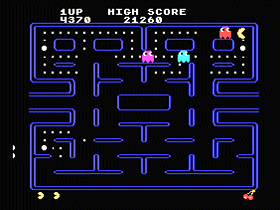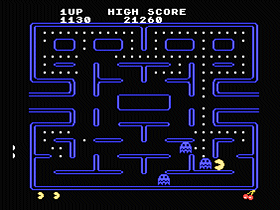 The Game: As a round yellow creature consisting of a mouth and nothing else, you maneuver around a relatively simple maze, gobbling small dots and evading four colorful monsters who can eat you on contact. In four corners of the screen, large flashing dots enable you to turn the tables and eat the monsters for a brief period. Periodically, assorted items appear near the center of the maze, and you can consume these for additional points as well. The monsters, once eaten, return to their home base in ghost form and return to chase you anew. If cleared of dots, the maze refills and the game starts again, but just a little bit faster… (Atarisoft, 1983)
The Game: As a round yellow creature consisting of a mouth and nothing else, you maneuver around a relatively simple maze, gobbling small dots and evading four colorful monsters who can eat you on contact. In four corners of the screen, large flashing dots enable you to turn the tables and eat the monsters for a brief period. Periodically, assorted items appear near the center of the maze, and you can consume these for additional points as well. The monsters, once eaten, return to their home base in ghost form and return to chase you anew. If cleared of dots, the maze refills and the game starts again, but just a little bit faster… (Atarisoft, 1983)
Memories: Having spent the better part of a year suing nearly every Pac-Man clone off the home video game market, Atari finally released its own version of the game for several consoles and home computer systems, including the TI 99/4a. TI had already released its own first-party take on the basic play mechanics of Pac-Man, Munch Man, which is generally considered one of the better arcade-style games released by TI itself. So did Atari’s “official” Pac-Man live up to its competition on the TI?
 Surprisingly, the answer is both yes and no. Pac-Man looks and sounds great on the TI, but in the early screens the game is oddly slow – not a problem from which Munch Man suffered. Somewhere between the two are the necessary ingredients for one really good game. TI Pac-Man doesn’t get anything intensely wrong about the original game – it’s a fine game of Pac-Man – but in the end I find myself still rooting for Munch Man, just because it is different from the source material.
Surprisingly, the answer is both yes and no. Pac-Man looks and sounds great on the TI, but in the early screens the game is oddly slow – not a problem from which Munch Man suffered. Somewhere between the two are the necessary ingredients for one really good game. TI Pac-Man doesn’t get anything intensely wrong about the original game – it’s a fine game of Pac-Man – but in the end I find myself still rooting for Munch Man, just because it is different from the source material.
 With the oddly sluggish game play, Pac-Man is a decent game, but not the arcade-authentic experience that some players might expect from a computer as relatively powerful for its day as the TI. It’s not a major disappointment, just enough instances of the game feeling slightly “off” that it adds up.
With the oddly sluggish game play, Pac-Man is a decent game, but not the arcade-authentic experience that some players might expect from a computer as relatively powerful for its day as the TI. It’s not a major disappointment, just enough instances of the game feeling slightly “off” that it adds up.
